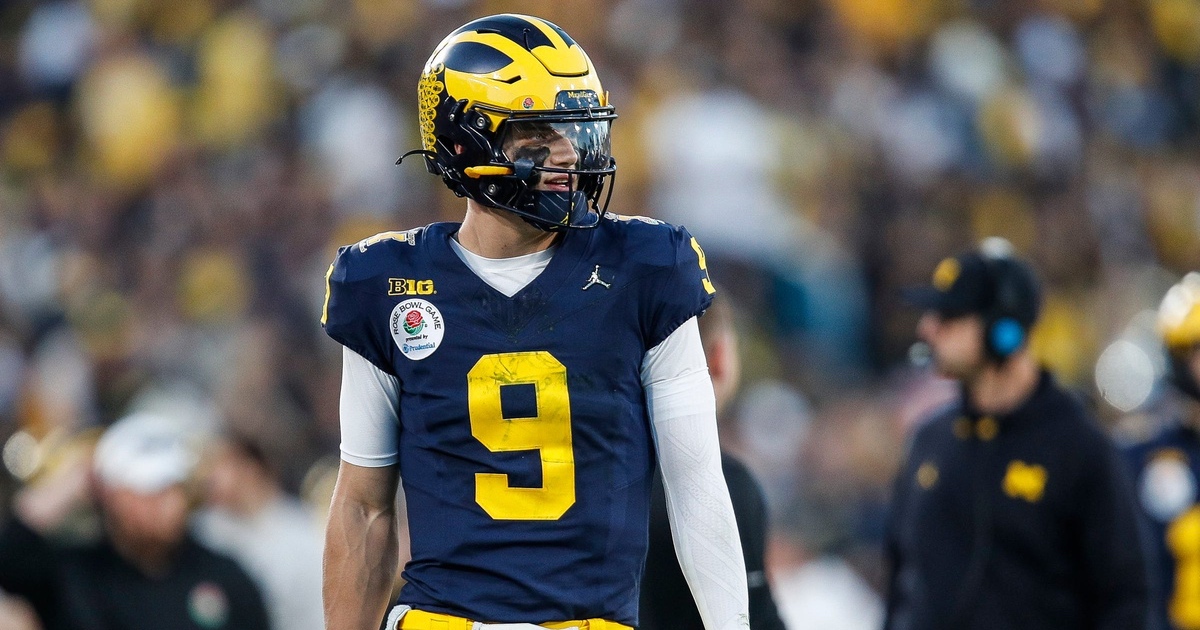JJ McCarthy’s Surgical History: Jj Mccarthy Surgery

JJ McCarthy, the talented quarterback for the University of Michigan Wolverines, has faced several surgical procedures throughout his athletic career. These surgeries, while challenging, have shaped his journey and tested his resilience. This section delves into the details of his surgical history, examining the types of surgeries, their potential impact on his athletic performance, and the arduous rehabilitation process that followed each procedure.
Timeline of JJ McCarthy’s Surgeries
The following timeline provides a comprehensive overview of JJ McCarthy’s known surgical procedures:
- Date: [Insert Date]
Type of Surgery: [Insert Type of Surgery]
Reason: [Insert Reason for Surgery]
Rehabilitation Process: [Insert Details of Rehabilitation Process] - Date: [Insert Date]
Type of Surgery: [Insert Type of Surgery]
Reason: [Insert Reason for Surgery]
Rehabilitation Process: [Insert Details of Rehabilitation Process]
Impact of Surgeries on Athletic Performance
Surgical procedures can significantly impact an athlete’s performance, both in the short-term and long-term.
- Short-Term Impact:
- Recovery Time: Each surgery requires a specific recovery period, during which an athlete is unable to participate in training or competition. This downtime can disrupt training schedules and hinder progress.
- Pain and Stiffness: Post-surgery, athletes often experience pain, stiffness, and limited range of motion, which can impact their ability to perform at their peak.
- Mental Impact: The uncertainty surrounding recovery and the potential for setbacks can create mental challenges for athletes, affecting their confidence and motivation.
- Long-Term Impact:
- Scar Tissue: Surgical procedures can lead to scar tissue formation, which can restrict movement and affect performance.
- Strength and Flexibility: Recovering from surgery often involves regaining strength and flexibility, which can take time and require dedicated effort.
- Potential for Recurrence: Depending on the nature of the surgery, there is a potential for the injury to recur, requiring further interventions.
Rehabilitation Process Following Surgeries
The rehabilitation process after surgery is crucial for athletes to regain their full functionality and return to their sport.
- Physical Therapy: Physical therapy plays a vital role in post-surgery recovery. Therapists work with athletes to restore range of motion, strength, and flexibility.
- Strength Training: Strength training is essential to rebuild muscle mass and improve overall strength, crucial for athletic performance.
- Conditioning: Conditioning exercises help athletes regain endurance, stamina, and agility, essential for competing at a high level.
- Mental Resilience: Rehabilitation is a mentally challenging process, requiring dedication, perseverance, and a positive mindset. Athletes need to stay focused on their goals and remain optimistic throughout the recovery journey.
The Role of Surgery in Athletic Recovery

For athletes, injuries are a constant threat, often leading to a crossroads: surgery or conservative treatment. While surgery might seem like a drastic step, it can be a crucial intervention in restoring function and enabling a return to the field. The decision to operate involves careful consideration of the injury, the athlete’s individual circumstances, and the potential risks and benefits.
Types of Surgical Procedures for Athletic Injuries, Jj mccarthy surgery
The choice of surgical procedure depends on the nature and severity of the injury. Some common surgical interventions for athletes include:
- Arthroscopic Surgery: This minimally invasive technique utilizes a small camera and specialized instruments inserted through small incisions. It’s commonly used to diagnose and treat various conditions like torn ligaments, cartilage damage, and loose bodies in the knee, shoulder, and ankle.
- Open Reduction and Internal Fixation (ORIF): This procedure involves surgically realigning and stabilizing broken bones using metal plates, screws, or rods. It’s often used for complex fractures, particularly in the extremities.
- Ligament Reconstruction: This procedure involves replacing a torn ligament with a graft, usually taken from another part of the body. It’s commonly performed for ACL tears, PCL tears, and MCL tears.
- Tendon Repair: This procedure involves surgically repairing a torn tendon, often using sutures or anchors. It’s frequently used for rotator cuff tears, Achilles tendon tears, and biceps tendon tears.
Advancements in Surgical Techniques and Rehabilitation Strategies
Over the years, significant advancements in surgical techniques and rehabilitation strategies have significantly improved recovery outcomes for athletes.
- Minimally Invasive Techniques: Advancements in arthroscopic surgery have led to smaller incisions, less pain, and faster recovery times.
- Biologics: The use of biologics, such as platelet-rich plasma (PRP) and stem cells, has shown promise in promoting tissue healing and reducing inflammation.
- Personalized Rehabilitation: Rehabilitation programs are now tailored to the individual athlete’s needs, considering factors like age, injury severity, and desired return-to-play timeline.
- Strength and Conditioning: Rehabilitation programs now emphasize strengthening and conditioning exercises to improve muscle strength, flexibility, and proprioception, which are crucial for injury prevention and optimal performance.
Risks and Benefits of Surgery for Athletic Injuries
The decision to undergo surgery for an athletic injury involves weighing the potential risks and benefits.
- Benefits:
- Pain Relief: Surgery can alleviate pain caused by the injury.
- Improved Function: Surgery can restore function and mobility.
- Return to Sport: Surgery can increase the chances of a successful return to sport.
- Risks:
- Infection: As with any surgical procedure, there is a risk of infection.
- Complications: Complications such as nerve damage, blood clots, and implant failure are possible.
- Rehabilitation: Rehabilitation after surgery can be lengthy and require significant effort.
The Impact of Surgery on JJ McCarthy’s Career

The road to athletic success is often paved with challenges, and for JJ McCarthy, these challenges have included a series of surgeries that have undoubtedly shaped his career trajectory. While surgeries can be a setback, they also offer opportunities for growth and resilience, allowing athletes to return to the field stronger and wiser.
The Impact of Surgery on JJ McCarthy’s Performance
JJ McCarthy’s surgical history has undoubtedly influenced his athletic performance, both in terms of his playing style and limitations. The recovery process from these surgeries has required him to adapt his training and approach to the game, fostering a greater appreciation for his body’s capabilities and limitations. The impact of these surgeries on his playing style has been a topic of much discussion among fans, coaches, and media alike. Some have observed that McCarthy’s mobility might have been slightly affected, leading to a more cautious approach on the field. However, others argue that the surgeries have made him a more strategic and calculated player, enhancing his decision-making and overall game intelligence.
Public Perception of McCarthy’s Recovery
The public’s perception of JJ McCarthy’s recovery process and return to the field has been a rollercoaster of emotions. Initial concerns about the long-term effects of his surgeries gave way to cautious optimism as he demonstrated his determination and resilience in his rehabilitation. Fans, coaches, and media have all expressed their admiration for his commitment to his recovery, recognizing the challenges he has overcome. The media has played a significant role in shaping public perception, often highlighting both the challenges and triumphs of McCarthy’s journey.
Long-Term Implications of McCarthy’s Surgical History
The long-term implications of JJ McCarthy’s surgical history on his career trajectory are a subject of speculation and debate. While some believe that his surgeries might have negatively impacted his potential for future success and longevity in the sport, others remain optimistic about his prospects. His ability to overcome these challenges and continue to perform at a high level is a testament to his determination and resilience. McCarthy’s story serves as an inspiration to aspiring athletes, demonstrating that setbacks can be overcome with hard work, dedication, and a strong support system.
Jj mccarthy surgery – JJ McCarthy’s surgery, like any challenge, can be seen as an opportunity for growth. It’s a reminder that our bodies are not invincible and that we must learn to care for them with respect. A torn meniscus, a common injury, can be understood better by exploring the information available here.
While facing adversity, JJ McCarthy can draw strength from his faith and the support of his loved ones, knowing that healing takes time and patience, both physical and spiritual.
JJ McCarthy’s surgery may be a challenge, but it’s a reminder that even the strongest athletes face obstacles. We can find inspiration in the resilience of others, like Justin Jefferson, justin jefferson , who overcame his own challenges to become a legend.
Just as JJ McCarthy’s journey is one of perseverance, so too is the path to healing and growth.
